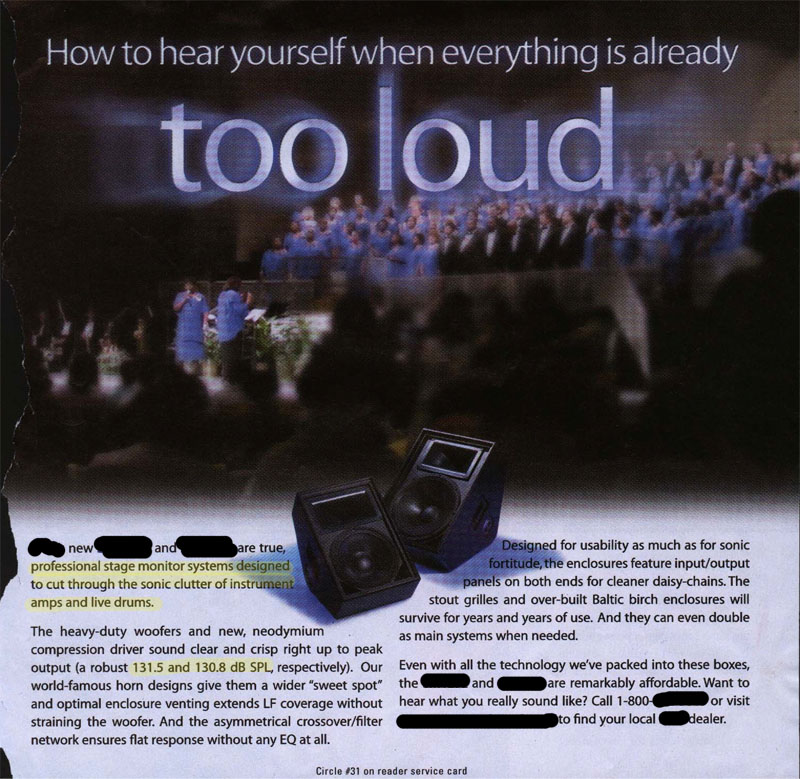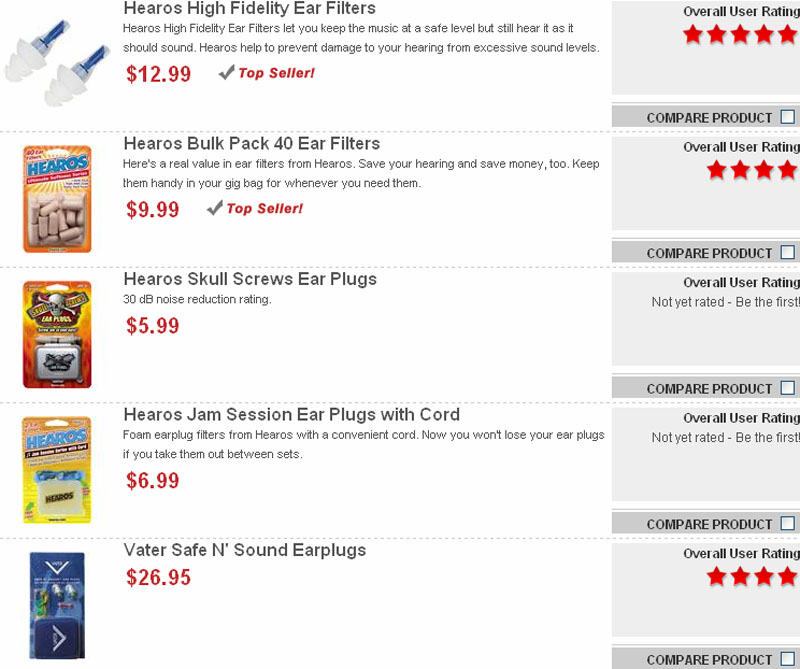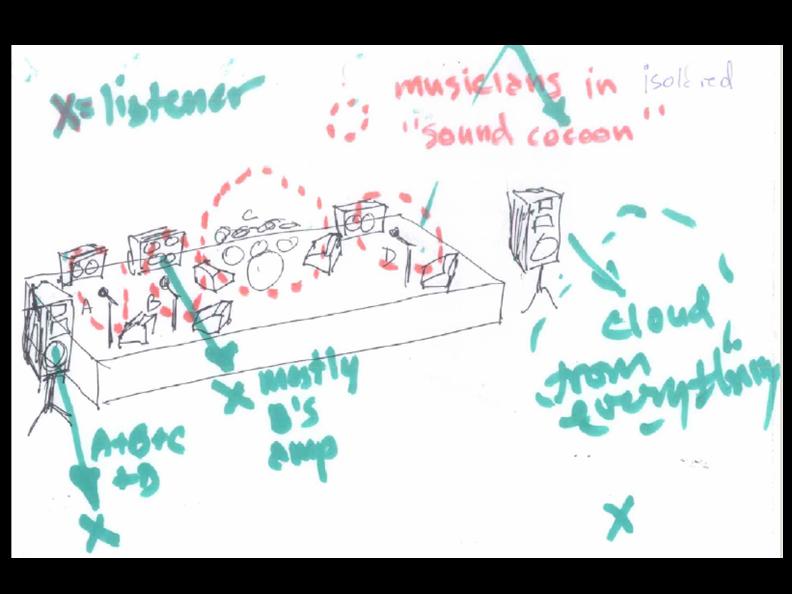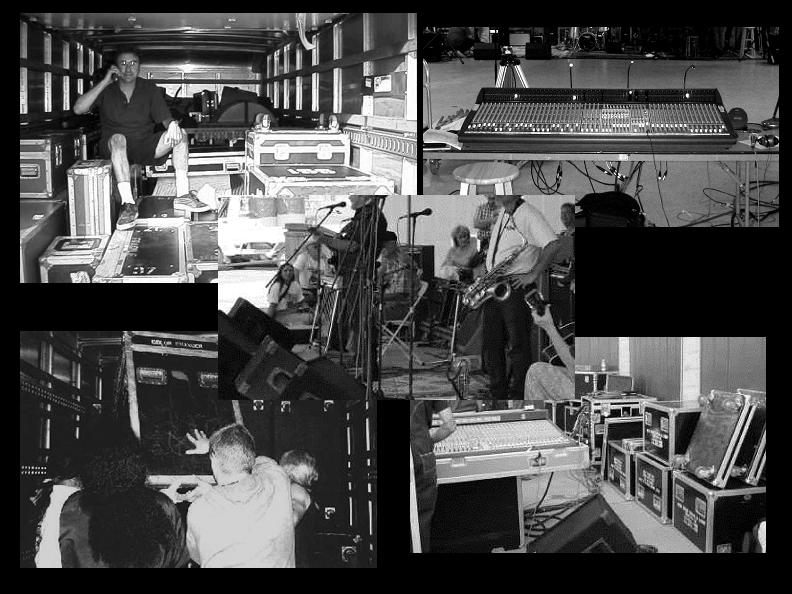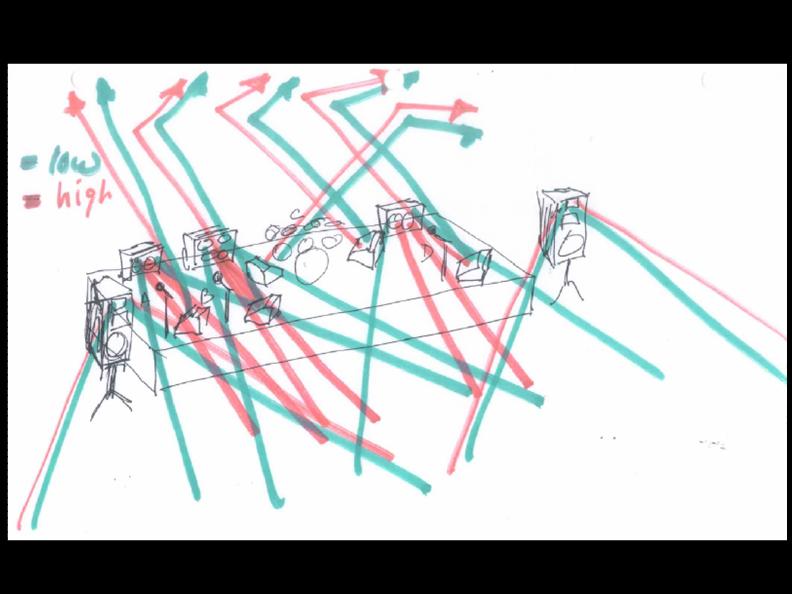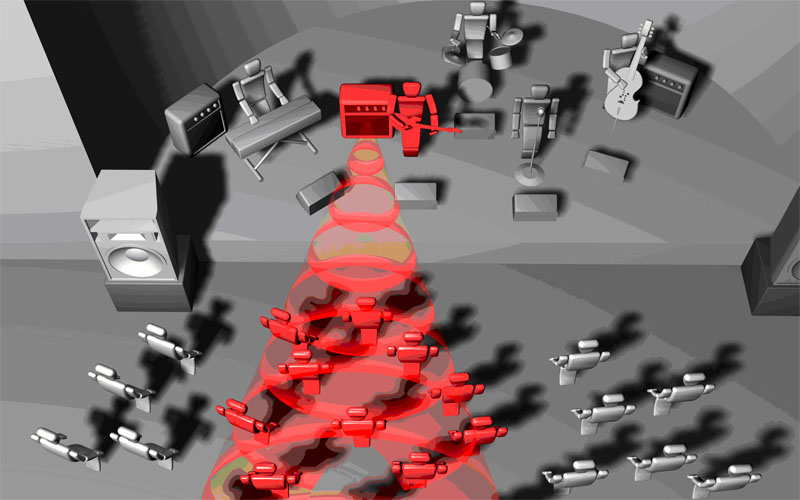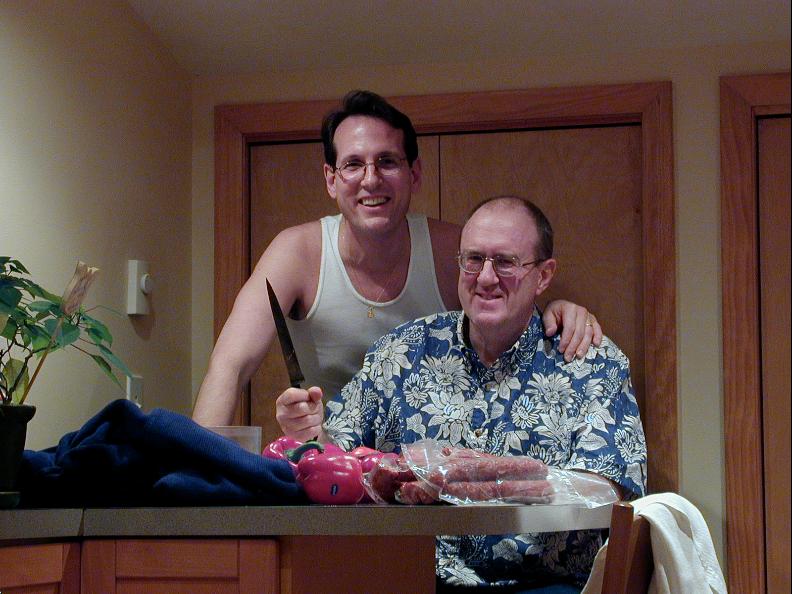Catalog of Live Music Research Problems
In Bose's work to understand why musicians and audiences were complaining about live amplified music, we eventually boiled things down to several key problems.
Contents
Excessive Loudness
One of the biggest problems was excessive sound levels.
Bose felt that the single greatest contribution our industry had brought to live music were loudspeakers that were ever more powerful, and that sound levels on stage and in the audience were uncomfortably, even dangerously loud.
Ken occasionally said in Bose's L1 introduction presentation, called Music is Human that if a friendly alien appeared on earth, and found out music was one of our most valued activities, that it was largely experienced through the ears, but that we had busily spent the past 50 years developing loudspeakers that could literally break the ears, or short of that make music monstrously difficult to hear because it was so loud, they'd probably get back in their spaceship and leave, concluding we could not be understood.
This is an advertisement years ago when Cliff and Ken were starting out. It was in a magazine for worship leaders.
"How to hear yourself when everything is already too loud."
Answer:
Be louder.
Cliff and Ken felt that something was terribly, terribly wrong.
One of the other things they knew about was a rapidly growing category of products: earplugs for musicians.
Take music. Crank it so that it's dangerously loud and where you can't hear well because you're ears are distorting...
And THEN sell musicians and audience members earplugs.
Mono Sound
You see a band arrayed before you, with musicians left to right.
But the sound all comes from a single location -- the location of the PA speaker nearest you. So if you're left of the centerline, the sound comes from the left stack and if you're right of the centerline it comes from the right.
That was always a fundamental disconnect for Ken. It's like turning technicolor into black and white.
When the L1 research project started, Ken didn't know explicitly how much listeners were missing in "squeezing" all the music into PA stacks. Intuitively he felt it was a lot. He'd heard small classical music ensembles, and unamplified string bands, and knew how gorgeous the spatial presentation of the sound was. He was intrigued with the Dead's Wall of Sound system for a long time, where at least some of the spatial correctness was preserved, but he'd never heard it.
He'd never done an instantaneous A/B comparison with something better.
All of that was to come later.
(This sketch was done by Cliff, fairly early on.)
As Cliff and Ken continued discussing this particular issue, they began to understand the problem as two distinct problems, traceable to two distinct capabilities in our sensory system.
The first was easier to unravel because it was in the field of psycho-acoustics, which they both already knew quite a bit about. And there were many others here that did too and that helped occasionally in early discussions. Research engineer Chris Ickler was phenomenally knowledgeable in these areas and he worked in the same group as Cliff and Ken.
The first problem has to do with how we hear sound sources in the presence of noise. When the source comes from a unique direction we can hear it much better. Conversely, when the source comes from the same direction as competing sources it's much harder to hear. This basic feature of our hearing system is at the heart of a great deal of research into various phenomena such as what's called "The Cocktail Party Effect" or "Binaural Unmasking".
In music, if you can keep the sources separate, so that they come from different directions, it is much easier to pick out and hear any one of those sources.
There is a fantastic talk on this subject by Bose research engineer Chris Ickler at the 5th L1 Conference in Little Switzerland in May 2008. There's a demonstration of the Cocktail Party Effect that Chris included that you can easily hear on your computer speakers.
You can watch a really cool video of Chris's talk on psychoacoustics including the cocktail party effect demo.
The second part of the problem is very interesting and not well documented. It falls broadly into the category of "sensory integration" or how our senses work together.
From a young age, we were taught that there were five senses. The implication was that they are all separate and we tended to think of them that way.
But it's not true. For example, the way we experience food is a complicated integration of ALL the senses. The experience isn't simply the sum of what the individual senses are "saying". It's much more complicated than that.
There's a very interesting and relevant example of sensory integration when it comes to vision and hearing. Namely, in certain critical situation, employing eyes and ears in concert results in a much more powerful experience than if one or the other is employed alone.
As an example, there is an amazing experiment that shows that if we are trying to listen to someone talk in the presence of competing noise (say other people talking) and you can look at them while they are talking, it can be the equivalent of turning the volume level of all the competing noise down by 10 dB! Even though we don't think we lip read, we do. And we're taking many other cues from the visual to help with the auditory.
The problem with a conventional PA, is that the sound (all of it) comes from a single direction that does NOT correspond to what we see. When we hear something that interests us we first have to scan the stage to see what musician is making that sound, and then we use our senses together. But the whole time we're searching we're not enjoying the deeper experience that comes from using our hearing and vision together. We're doing administrative work instead.
Too Much Gear
Both Cliff and Ken were very familiar with what it took to do a gig in terms of gear and logistics. Both had done it their whole adult lives. They felt that technology had made it progressively harder, not easier.
On a gig day, or maybe even a few days before, the process would begin to collect all the gear, get it transported, and set up. If you were in charge, as both of us often were, this usually was some sort of all day affair, especially if you were trying to make sure that the setup was professional.
By the time the music started, hours and hours of hard work and logistical thinking had already transpired.
There were so many wires, and of so many different kinds.
And then after the music ended, you'd have to do the whole darned thing in reverse.
Both felt that this whole process flew directly in the face of music making. Many times, they felt they were wiped out and their brains exhausted just getting set up. And it often wasn't possible to enjoy the afterglow of a great performance knowing there were hours more work ahead because of the gear.
Real problems would sometimes arise between band members because some helped with the gear much more than others, and resentments set in.
Ken said that the only shoving match he ever initiated was over gear set up. Someone in the band showed up really late to a load in up a long flight of stairs on a brutally hot and humid day. He says he's regretted this his whole life.
Excessive Reverberation
The job of the professional sound engineer is to get clear sound in the audience area, among other things.
But the more you learn about acoustics the more frustrating it becomes to do that because you can see (and hear) that you're fighting against a tsunami of chaotic sound.
The problem, ably illustrated in another early sketch by Cliff, is that lots of sound makes it to the audience area other than from the PA speakers -- the one part of the three-part triple system intended exclusively for them.
There's lots of sound from the monitors which splash sound all over the place, and from the backline amps, which laser-beam their sound to some parts of the audience (more on that later) and totally miss others.
How can a sound engineer possibly solve this problem?
That's one reason many live shows lack clarity. If you were to turn off the PA speakers completely, you'd still hear tons of sound, and none of it clear. Turning the PA speakers back on doesn't make the mush go away. Now you have to turn up the PA really loud to overcome the mush. And now, you've got music that's just too loud.
Excessive Directionality from Guitar Amps
Cliff and Ken have said publicly many times how much they both LOVE electric guitar.
Ken can honestly say that some of his best experiences listening to music has been with great electric guitarists: Hendrix, Vaughan, Christian, Metheny, and so on.
But live, they knew that the extremely narrow beam of sound from guitar amps could be and often was, disastrous.
They found that guitar players almost never stand right in front of their backline amplifiers.
That’s because these speakers are so directional that the sound level and tone directly in front is incredibly harsh.
But some audience members are in the direct line of fire and get blasted by the guitar sound.
Even if it’s not a terribly loud show, they still hear a mix that’s inappropriately dominated by the guitar.
The musicians on stage don’t fare very well either.
Either they’re on axis of the guitar and therefore blasted by its directional beam, or they’re off axis and only hear a dull version of the instrument – a version that’s hardly representative on the tone carefully created by the guitarist.
We came to the conclusion that in this environment, there is only one person with any hope of getting good guitar sound, and that is the guitarist.
If anyone doubts this, they are encouraged to take a guitar amp on wheels, have a guitarist strum a chord that excites all or most of the strings, and then slowly have someone rotate the amp. Stand in front of it.
Cliff and Ken both feel that it is not very difficult after that to realize how many problems are being caused by these amps.
Artists Not In Control Of Their Art
One of the most fundamental problems Cliff and Ken discussed was one they felt was of perhaps the greatest magnitude in terms of musical art.
With triple systems, musicians were not in control of their art.
Here's how Ken put it when it came time to launching the L1 system in 2003 in the multi-media presentation called Music is Human:
All of these problems that we’ve just discussed pale in comparison to this last one, one even more fundamental, because it strikes at the very heart of how musical artists connect with their audiences.
In the triple-system approach, the voices and instruments are electronically mixed one way for the audience through the PA system, and a different way for each musician through the monitor system.
This mixing is done by a sound operator typically positioned in the audience.
In such an arrangement, the musicians initiate the sound, but then they immediately lose control of it to the person operating the mixing board.
They don’t control how they sound to themselves in their monitors, and they don’t control how they sound to their fellow musicians in theirs.
And yet the person who does control the monitors can’t hear what they’re doing because they’re not on stage!
In the case of the PA mix for the audience, musicians have no idea what the person operating the mixing console has done to their sound.
So in the case of the monitors, adjustments are made to the sound by someone who’s not in the group and who can’t hear what they’re doing. This is a major reason why musicians complain so bitterly about the sound in their monitors.
In the case of the PA mix major adjustments are being made to the sound that the people who are in the musical group can’t hear at all.
Is it really any wonder, then, that in our research the most common thing we heard from musicians after a performance using the triple system approach was “How did we sound?”!!!
Imagine a painter whose every mark is altered by someone else, and worse, is forced to look away as these alterations are made.
Do this, and you’ll have some idea of the handicap musicians must endure, and the frustrations they feel.
To Cliff and Ken, this was the mother of all problems. Artists not in control of their art. Something had gone seriously, seriously wrong.
And so, it was with a full and lengthy discussion over many weeks and months of the problems plaguing live amplified music that they set out on the attack...
Actually, in this photo, from about the same time, Cliff and Ken were prepping for a huge batch of seafood gumbo. Cliff knew a sound engineer in New Orleans who was tapped into the local cuisine. He arranged fly crabs, shrimp, and sausage to us on ice.
They threw a big party that night with live music over at the Village Hall.
